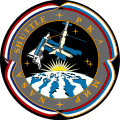NASA career
Thagard was selected as an astronaut candidate by NASA in January 1978. [2] In August 1979, he completed a one-year training and evaluation period, making him eligible for assignment as a mission specialist on future Space Shuttle flights. A veteran of five space flights, he logged over 140 days in space. He was a mission specialist on STS-7 in 1983, STS-51-B in 1985, STS-30 in 1989, was the payload commander on STS-42 in 1992, and was the cosmonaut/researcher on the Russian Mir EO-18 mission in 1995, which saw him launch aboard Soyuz TM-21 (the first American to launch in a Soyuz) and land on STS-71.
Thagard first flew on the crew of STS-7, which launched from Kennedy Space Center, Florida, on June 18, 1983. This was the second flight for the Orbiter Challenger and the first mission with a crew of five. During the mission, the STS-7 crew deployed satellites for Canada (ANIK C-2) and Indonesia (Palapa B1); operated the Canadian-built Remote Manipulator System (RMS) to perform the first deployment and retrieval exercise with the Shuttle Pallet Satellite (SPAS-01); conducted the first formation flying of the Orbiter with a free-flying satellite (SPAS-01); carried and operated the first U.S./German cooperative materials science payload (OSTA-2); and operated the Continuous Flow Electrophoresis System (CFES) and the Monodisperse Latex Reactor (MLR) experiments, in addition to activating seven "Getaway Specials." During the flight, Thagard conducted various medical tests and collected data on physiological changes associated with astronaut adaptation to space. He also retrieved the rotating SPAS-01 using the RMS. Mission duration was 147 hours before landing at Edwards Air Force Base, California, on June 24, 1983. [3]
Thagard then flew on STS-51-B, the Spacelab-3 science mission, which launched from Kennedy Space Center, Florida, on April 29, 1985, aboard Challenger. During the mission he served as flight engineer, sitting on the flight deck and assisting the commander and pilot during ascent and entry. Mission duration was 168 hours. Duties on orbit included satellite deployment operation with the NUSAT satellite as well as animal care for the 24 rats and two squirrel monkeys contained in the Research Animal Holding Facility (RAHF). Other duties were operation of the Geophysical Fluid Flow Cell (GFFC), Urinary Monitoring System (UMS) and the Ionization States of Solar and Galactic Cosmic Ray Heavy Nuclei (IONS) experiment. After 110 orbits of the Earth, Challenger landed at Edwards Air Force Base, California, on May 6, 1985. [4]
He next served on the crew of STS-30, which launched from Kennedy Space Center, Florida, on May 4, 1989, aboard the Orbiter Atlantis . Thagard again served as flight engineer. During this four-day mission, crew members deployed the Magellan Venus-exploration spacecraft, the first U.S. planetary science mission launched since 1978, and the first planetary probe to be deployed from the Shuttle. Magellan arrived at Venus in mid-1990 and mapped the entire surface of Venus using specialized radar instruments. In addition, crew members also worked on secondary payloads involving fluid research in general, chemistry and electrical storm studies. Mission duration was 97 hours. Following 64 orbits of the Earth, the STS-30 mission concluded with a landing at Edwards Air Force Base, California, on May 8, 1989. [5]
Thagard served as payload commander on STS-42, aboard the orbiter Discovery , which lifted off from the Kennedy Space Center, Florida, on January 22, 1992. Fifty five major experiments conducted in the International Microgravity Laboratory-1 module were provided by investigators from eleven countries, and represented a broad spectrum of scientific disciplines. During 128 orbits of the Earth, the STS-42 crew accomplished the mission's primary objective of investigating the effects of microgravity on materials processing and life sciences. In this unique laboratory in space, crew members worked around-the-clock in two shifts. Experiments investigated the microgravity effects on the growth of protein and semiconductor crystals. Biological experiments on the effects of zero gravity on plants, tissues, bacteria, insects and human vestibular response were also conducted. This eight-day mission culminated in a landing at Edwards Air Force Base, California, on January 30, 1992. [6]
On his last mission, Thagard was a crew member for the Russian Mir EO-18 mission. Twenty-eight experiments were conducted in the course of the 115-day flight. The crew lifted off from the Baikonur Cosmodrome in Kazakhstan aboard Soyuz TM-21 on March 14, 1995. The mission culminated in a landing at the Kennedy Space Center on the Space Shuttle Atlantis flight STS-71 on July 7, 1995. [1]
Post-NASA Career
Thagard retired from NASA in December 1995 [1] and joined the faculty of Florida State University at Tallahassee. [7] He became a tenured professor and associate dean for college relations in the FAMU - FSU College of Engineering. [8]
In 1996, at the request of the Smithsonian Institution, Thagard's Russian "SOKOL" space suit was donated to the National Air & Space Museum [9] Norman Thagard also served as an aerospace consultant and was technical advisor for Virus, a 1999 film starring Jamie Lee Curtis and Donald Sutherland, [10] and for Armageddon (1998) starring Bruce Willis, Ben Affleck, and Liv Tyler.
In 1998, Norm Thagard was appointed to the Board of Directors of EMS Technologies, Inc. EMS is an Atlanta-based communications company. [11]
In 2003, Thagard co-founded the Challenger Learning Center of Tallahassee, with shuttle/mission control/space station simulators, digital space theater/planetarium and IMAX theater. Thagard's interest in part was driven by his close friendship with the family of Challenger astronaut Dick Scobee. [12] He also serves as an advisor for Space Adventures, Ltd., a company offering aerospace experiences, including orbital flight. [13]
In 2009, Thagard was elected Fellow of the American Institute of Aeronautics and Astronautics. [14] He was also a member of the Editorial Review Board of the Journal of the Society for Human Performance in Extreme Environments.

